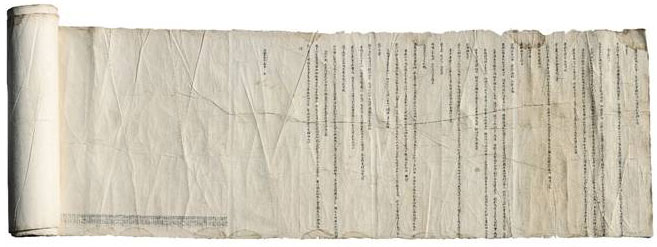E-mail : master@koreastudy.or.kr
Tel : 82-54-851-0700
The Advanced Center for Korean
Studies copyright ©2017
About Maninso

Maninso (萬人疏) literally means "Sangso with 10,000 people's names." Maninso can be Sangso proposed by Confucian scholars living outside the politics at the risk of their lives, and it can mean movement of Sangso as well. As about 10,000 people prepare a petition in which their own names are written and work together to submit it to the king, the movement naturally occurs. Then, through this movement Maininso is finally created. Maininso refers to Sangso with 10,000 people's naems in a narrow sense, but in a broader sense it means the entire movement of creating Maninso and preparing for submission.
Maninso movement is a fruit of the unique political culture of the Joseon dynasty. The political culture where the petitions with scholars' opinions were heavily valued and Confucian scholars who executed these in the level of practical movements together produced this product. Maninso is concentrated between the late 18th to 19th, and there were approximately seven Maninso that satisfied the standard of the number of signers as "about 10,000 people."
| Name | Period | Head of Sangso | Number of Signers | Contents | Leading Power |
|---|---|---|---|---|---|
| Maninso to Redress the Status of Crown Prince Sado | 16th year of Jeongjo(1792) | Wu Yi | (Primary)10,057 (Secondary)10,368 |
Sangso to request for reinstatement of the status of Crown Prince Sado | Yusaeng from Yeongnam region |
| Maninso to Abolish Discrimination against Seo-eol | 23rd year of Sunjo(1823) | Hee-yong Kim | 9,996 | Sangso to request to allow Seo-eol to be able to enter government services | Yusaeng from the entire country |
| Maninso to Reinstate the Status of Crown Prince Sado as a King | 6th year of Cheoljong(1855) | Hui-byeong Yi | 10,094 | Sangso to request for reinstatement of the status of Crown Prince Sado as a King | Yusaeng from Yeongnam region |
| Maninso to Object the Demolition of Seowon | 8th year of Gojong(1871) | Min-byeong Jeong | 10,027 | Sangso to request to withdraw Daewongun's order to demolish Seowon | Yusaeng from Yeongnam region |
| Maninso to Reinstate the Status of Daewongun | 12th year of Gojong(1875) | (Primary) Min-chae Jeong →Jung-jin Lee (Secondary) Do-su Ryu→Jung-jin Lee | Not confirmed | Sangso to request for reinstatement of the status of Daewongun | Yusaeng from Yeongnam region |
| Cheoksa Maninso | 17th year of Gojong(1880) | (Primary) Man-son Lee (Secondary) Jo-yeong Kim (Tertiary) Seok-gyu Kim | Not confirmed | Sangso to request for execution of strong Cheoksawuijeong policies | Yusaeng from the entire country |
| Maninso to Oppose the Dress Reformation | 21st year of Gojong(1884) | Jae-gyo Lee | 8,849 | Sangso to request to cancel the dress reformation policy ordered during the 21st year of Gojong | Yusaeng from Yeongnam region |
As it is known to everyone, the Joseon dynasty strongly valued existence of scholars, who lived based on Confucian principles and beliefs, as an important method to fulfill the royal politics as per its founding principle, Confucianism. Especially, 'Seon-bi,' who does not long for power but keeps cultivating his mind, was set as an ideal person, and thoughts commonly shared by Seon-bi were regarded as the values for Confucian beliefs to support and follow. Therefore, Seon-bi was supposed to sacrifice oneself for fulfillment of the royal politics once he became an official after passing the state exam, and to monitor and watch over to see if the power of the state was well operating as per the Confucian principles if he was out of politics. During the Joseon dynasty, the Confucian scholars who were not in the positions of political power strongly stated their opinions if a matter was not right as per the Confucian principle, and the state itself also accepted these opinions seriously. Sangso is what this kind of political culture is expressed most directly. Thus, Joseon could have the well-developed political culture with the public opinions even though it claimed to be the royal regime (王政).
The political culture with the focus on the public opinions put more emphasis mainly on each individual's petitions in the early Joseon dynasty; however, they were changed to group petitions in the mid and late Joseon dynasty. It was more effective to have the petition movement as a group instead of an individual in order to become the public opinion; therefore, the format of Sangso with names written had increased. The original form of Maninso can be found from Baekinso (百人疏) for which more than 100 intellectuals submitted Sangso twenty two times in 1565 and Cheoninso (千人疏) in which names of more than 1,000 intellectuals were written in 1666. The Maninso movement happened in this background in 19th century resulted in the practical movement to criticize the inflexible political structure of the state and restrain it. The existing petition movement was expressed most actively in this movement.
Especially, the Maninso movement occurred intensively during the harsh time of Samjeong (三政) disorders in the 18th and 19th centuries. As the intellectuals who were not in the positions of political power directly represented people's pain and suffering, they thought they needed to recover the Confucian beliefs of the state and cut out the rotten part of power. Eventually this led to the Maninso movement. When the ordinary people chose the extreme way of a rebellion, these intellectuals made “the public opinions based on the heaven's plans" as the method to have their voices heard to the state. This is how the group petition, Sangso, was made with "approximately 10,000 signers," which signifies "all people" of the country. Maninso was the movement from the time when not only "the public opinion" was expanded from an individual to a group, but also the petiton was required to be embodied with the opinion of "all people."

